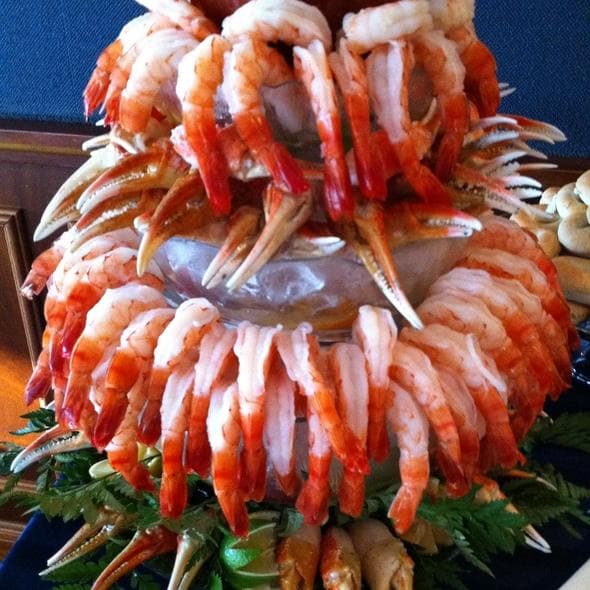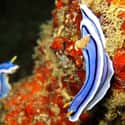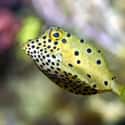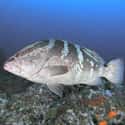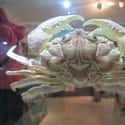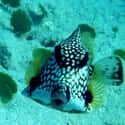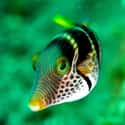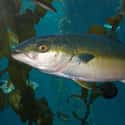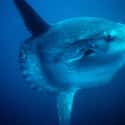-
(#1) Pufferfish
- Tetraodontidae
Pufferfish are members of the taxonomic family tetraodontidae, a group of robust fish that all have some level of toxicity to them. The pufferfish and it's many relatives produce tetrodotoxin, a chemical that is deadly to humans and roughly 1,200 times more potent than cyanide.
One pufferfish carries enough poison to kill 30 adult humans, but that hasn't stopped people from eating them. They are a delicacy in Japan, where they are called fugu. Japanese chefs have to be experts in the art of fuju because one small mistake during preparation is enough to be fatal.
-
(#2) Cuttlefish
- Sepiida
The flamboyant cuttlefish certainly lives up to its name. This Australian cephalopod is always changing color, possibly as a warning to potential predators about its toxicity. They are believed to be the most poisonous cuttlefish in the world, housing toxins that rival the deadly venom of the blue-ringed octopus.
The muscles of the flamboyant octopus are filled with potent toxins, so eating one could be enough to kill a human.
-
(#3) Stellate Puffer
Also known as the starry puffer, these animals are fairly large for a pufferfish. They can grow over a meter in length and can be found off the coasts of Australia. They are absolutely filled with toxins as their skin, muscles, livers, and genitals all test positive for high concentrations of tetrodotoxin and saxitoxin.
The ovaries of female stellate puffers are particularly toxic and can be fatal if ingested.
-
(#4) Greenland shark
- Somniosus microcephalus
These giant sharks are mysterious by nature, living in the far depths of the ocean and swimming slowly across the ocean floor. Their flesh is full of trimethylamine oxide, a toxic substance that can be very unpleasant for both humans and animals. In 1968, a dog sled team was fed the meat of a Greenland shark and experienced severe symptoms like muscular convulsions, vomiting, and explosive diarrhea. Some of the dogs even died, but that hasn't stopped humans from trying to eat this shark.
The people of Iceland have developed a special detoxification process that involves allowing the meat to rot for weeks. The food is considered a delicacy to some, but disgusting to others.
-
(#5) Nudibranch
- Nudibranchia
Nudibranchs are some of the most beautifully bizarre animals in the ocean. There are roughly 2,000 different species, all of which have their own color scheme. Often referred to as sea slugs, these flashy critters can pack a powerful punch when threatened.
Nudibranchs absorb toxins from the food they eat and store them inside their bodies, making them poisonous to most predators. Scientists aren't completely sure how the nudibranchs survive after ingesting so many toxins, but the amazing skill has proven to be an effective defense mechanism.
-
(#6) Barracuda
- Sphyraena
Barracudas are notorious for their frightening appearance and murderous appetite, but it's not just their teeth you should fear. Their flesh is rich with a nasty toxin known as ciguatoxin, which can induce ciguatera fish poisoning in humans. Barracudas are so poisonous, the Center for Disease Control and Prevention places them on top of their list of predatory fish to avoid.
While non-fatal, barracuda poisoning will wreak havoc on your digestive system and induce extreme nausea within 24 hours of consumption. Barracudas have such high toxin levels because the fish they eat consume a type of algae that produce ciguatoxin and the toxins build up in their bodies over time.
-
(#7) Striped Pyjama Squid
- Sepioloidea lineolata
There are not many poisonous cephalopods, but the striped pyjama squid is an exception to that rule. Its striped skin is believed to be a warning that these guys are not safe to eat. The have specialized glands on their bellies that secret a toxic slime if they are assaulted by a predator, rendering them unpalatable.
These squid-like creatures are actually a species of cuttlefish and not true squids.
-
(#8) Smooth toadfish
- Tetractenos glaber
The toadfish are another group of animals that are closely related to puffers, and they too are incredibly dangerous. Unlike other members of tetraodontidae, smooth toadfish lack the spines that can be found covering most pufferfish skin. The spines in a smooth toadfish are embedded in the skin, creating the smooth appearance from which the fish gets its name.
That doesn't mean they aren't deadly, as they are full of toxins and should never be eaten.
-
(#9) Yellow boxfish
- Ostracion cubicus
These cube-shaped fish are much tougher than they look. The yellow boxfish has armor plated skin and releases a powerful toxin when under duress. The toxin is known as ostracitoxin, and it's powerful enough to clear out a populated fish tank. It can even fall prey to its own toxin, which just goes to show how powerful it is.
Not surprisingly, this poisonous fish can be found off the coasts of Australia.
-
(#10) Giant moray
- Gymnothorax javanicus
Moray eels are one of the ocean's creepiest critters, and it turns out that some of them are actually poisonous. The giant moray eel is an example of a toxic eel, and their bites can be extremely unpleasant. They don't inject venom, however. Instead, the toxic effects come from the slimy mucus covering the skin around their mouths. Multiple different toxins can be found in the skin mucus and many of them can damage or destroy healthy red blood cells.
Unlike most poisonous sea creatures, moray eels don't ingest any of the toxins from their environment. Instead, they have specialized cells in their skin that can produce a wide range of different toxins.
-
(#11) Grouper
- Epinephelinae
Grouper is a common food, but an increase in ciguatera infections is causing some people to reevaluate their menu choices. The infection is similar to normal food poisoning, but there are some severe symptoms that are dramatically different.
Sensations of hot and cold can be reversed and heart rates can slow down drastically. The worst part about this poison is that the symptoms can often linger for years.
-
(#12) Xanthid Crab
There are many different crab species that are considered delicacies around the world. The xanthid crab, also known as Demania cultripes, is not one of them. They are high in tetrodotoxin and reports of human deaths after accidentally eating one have been common in some parts of the Indo-Pacific region.
The family Xanthidae is the classification given to xanthid crabs, many species of which are known to be toxic. It's likely that the crabs themselves aren't poisonous and that they absorb the toxins through their prey.
-
(#13) Blackspotted puffer
- Arothron nigropunctatus
Like other pufferfish, the blackspotted puffer is filled with harmful poisons. Certain parts of their bodies can cause intense reactions in humans that eat them. This species makes its home in the parts of the Indian and Pacific oceans and can be found around coasts across Southeast Asia.
While they come in many different colors, the black spots on their skin is the one constant throughout the species.
-
(#14) Smooth trunkfish
- Lactophrys triqueter
Trunkfish are closely related to boxfish and puffers, and these beautiful sea creatures are just as poisonous as their cousins. When threatened, these toxic fish secrete a lethal ichthyocrinotoxin from their skin that is released into the surrounding water. In tanks, trunkfish can easily kill themselves and other fish by releasing the toxin when stressed.
They are fairly slow swimmers, so trunkfish have to rely on their hardy scales and poisonous skin to deter predators. Even though they are toxic, they are eaten by humans in some countries.
-
(#15) Porcupinefish
- Diodontidae
While visually similar to pufferfish, the porcupinefish actually belongs to a separate family of fish known as diodontidae. Although they are different animals, some species of porcupinefish produce the exact same toxin as pufferfish.
Tetrodotoxin builds up in their internal organs, which keeps most predators away. There are a few exceptions, as some sharks, whales, dolphins, and tuna are known to prey on these clumsy swimmers.
-
(#16) Valentinni's sharpnose puffer
- Canthigaster valentini
Also known as the blacksaddle Toby, Valentin's sharpnose puffer is known to occupy the waters off the north coast of Australia. These puffers are so poisonous, other species of fish try to mimic them to trick potential predators.
Two species of coral trout are blacksaddle Toby mimics, taking advantage of the arsenal that these puffers have evolved over millions of years.
-
(#17) Greater Soapfish
Like many poisonous fish, the greater soapfish only produces its deadly toxin when under stress. The skin of the soapfish secretes a foaming substance that poisons the water around it. The substance is powerful enough to kill small fish, and most species of soapfish produce the toxin.
They get their name from the foamy appearance of their toxic slime.
-
(#18) Sea cucumber
- Holothuroidea
Sea cucumbers may look like vegetables, but they are actually most closely related to starfish and sea urchins. Most of the 1,250 species of sea cucumbers are bottom dwellers, living most of their lives on the sea floor. Sea cucumbers have developed a wide variety of defense mechanisms, and some even mutilate themselves by shooting their organs out of their anus when threatened.
Some species produce unique toxins that act as a defense against predators and as a way to digest their prey.
-
(#19) Yellowtail amberjack
- Seriola lalandi
The yellowtail amberjack is a popular seafood all over the globe, including countries like Japan, New Zealand, and the United States. What many people don't know is that they should be careful with amberjack, as they are carriers of the ciguatera bacteria.
Poisoning caused by this bacteria can lead to feelings of intoxication. Yellowtail amberjack are still viewed as a delicacy in many places. The Chinese have been dealing with amberjack-induced ciguatera poisoning for over 1,000 years.
-
(#20) Red snapper
- Lutjanus campechanus
Red snapper is another common seafood that is actually much more toxic than you would think. These are carriers of the ciguatera bacteria that has infected many fish species. Symptoms of ciguatera poisoning include numbness, nausea, vomiting, and headache.
Some snappers can grow to weigh as much as 50 pounds, and their bright red coloration makes them unmistakable. Even with the threat of food poisoning, red snapper remains commonplace on menus throughout the United States.
-
(#21) Ocean sunfish
- Mola mola
The ocean sunfish, also known as the mola mola, is a massive, clumsy fish. They are the heaviest bony fish in the world and some can weigh as much as 5,000 pounds. While they may be huge, their ridiculous body shape makes them completely harmless to pretty much everything but jellyfish.
Recent studies have shown trace amounts of toxic buildup in the livers of these animals, which could act as a poison to deter predators.
New Random Displays Display All By Ranking
About This Tool
The ocean is the most mysterious place on the planet. It is said that scientists do not even know half of the underwater world. Humans are still exploring the mysterious ocean. Numerous deadly sea creatures lurking in the dark waters, their toxins can instantly kill adult humans, among them are some seemingly beautiful and harmless creatures. There is never a lack of the oldest species which become unique and dangerous creatures in the ocean due to evolution.
The poison of a box jellyfish is enough to kill 60 adults and it can kill an adult in 30 seconds. The random tool lists 21 of the most poisonous sea creatures on the planet. People should notice surroundings when swimming in the sea or playing on the beach.
Our data comes from Ranker, If you want to participate in the ranking of items displayed on this page, please click here.

